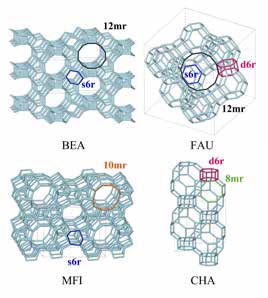Nitrogen oxides (NOx) is a collective term for nitric oxide (NO) and nitrogen dioxide (NO2). These are harmful substances emitted from combustion processes including diesel engines. NOx emissions contribute to ozone depletion, smog formation, and human health problems. Therefore, increasingly stringent emission legislation has been introduced over the last decades, to ensure only limited amounts of NOx are released to the atmosphere. Catalytic NOx removal is often carried out through selective catalytic reduction (SCR), using ammonia (NH3) as the reductant. NH3-SCR is an efficient method to convert NOx to nitrogen and water. It is a challenge to ensure catalytic efficiency over the entire range of operating conditions. This is especially true for automotive applications since fluctuations in the operating temperature are inevitable.
CHA zeolite is an artificial silica-aluminate mineral with ion-exchange properties. Over just a few years the copper exchanged version, Cu-CHA has been successfully commercialized as an SCR catalyst. This catalyst is especially attractive for NH3-SCR due to its high stability at operating conditions. However, the catalytic mechanism is not fully understood. This is an obstacle for further development of the catalyst.
In this project, both in-situ electron paramagnetic resonance (EPR) spectroscopy and ex-situ ultraviolet-visible (UV-Vis) spectroscopy were applied to examine the coordination environment of copper in the zeolite structure under dehydration and during exposure to SCR relevant gasses. Results from the UV-Vis investigations were found to be in agreement with the EPR results.
Several copper sites were found in CuCHA after activation at elevated temperatures. They were assigned to separate Cu2+ locations in the zeolite structure. From analysis of EPR spectra of dehydrated CuCHA with different Cu loading, the distribution of Cu sites was assigned and quantified.
Copper prefers to be in the vicinity of two aluminium in the zeolite framework structure but can also be found in less preferred sites with only one aluminium in the vicinity. The reactivity of copper is known to be different depending on the number of aluminium in the proximity. The surprising result of this project is that the oxidation reactivity can be further differentiated. Conditions can be chosen where only one type of sites will react with the oxidizing gas. Thus, the site preferred by copper upon ion exchange was shown to be the least reactive whereas the less preferred exchange site was shown to be the most reactive site for reaction with SCR relevant
gasses, NH3, NO and O2.
 The project has revealed how EPR spectroscopy can be applied at catalytic relevant temperatures (100 -300 °C) and gas flow rate and compositions without compromising spectral quality. It has revealed how formation and decomposition of copper coordinated to ammonia or nitrate can be
The project has revealed how EPR spectroscopy can be applied at catalytic relevant temperatures (100 -300 °C) and gas flow rate and compositions without compromising spectral quality. It has revealed how formation and decomposition of copper coordinated to ammonia or nitrate can be
followed in real time.
Based on these findings, mechanistic details of the interaction between the active copper and the gasses could be revealed and a new suggestion for the mechanism of the SCR reaction on these materials were proposed.
Illustration:
Drawing of the four zeolite frameworks: BEA, FAU, MFI and CHA. Important structure sites are marked and labeled. s6r: single 6 membered ring. d6r: double 6 membered ring. Xmr: X membered ring.